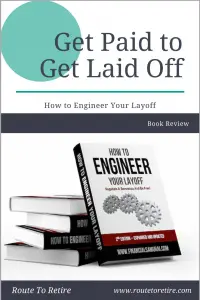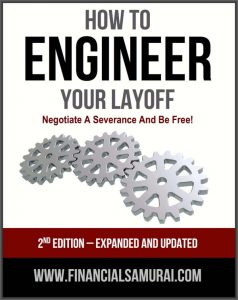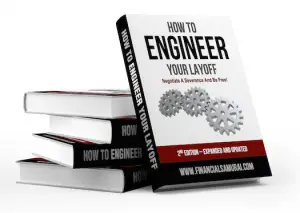Disclosure: This post contains affiliate links and we may receive a referral fee (at no extra cost to you) if you sign up or purchase products or services mentioned. As an Amazon Associate, I earn from qualifying purchases.
 If you’ve been working long enough, you’ve probably been a part of or know of a company that has needed to layoff some of its employees at one point or another.
If you’ve been working long enough, you’ve probably been a part of or know of a company that has needed to layoff some of its employees at one point or another.
It’s never a pretty situation for anyone – obviously, the employee doesn’t like ’em, but most managers and bosses hate having to go through this ordeal as well.
In Sam Dogen’s book, “How to Engineer Your Layoff,” he talks about how to take a grim situation like a layoff and actually turn it into a positive… potentially a huge financial positive.
Those of you who have been following my story know that I plan to quit my job by 2025. With that said, this book definitely piqued my interest.
Could I figure out a way to leverage some of the advice in this book for my own circumstances?
One way to find out! 🙂
First off, know that I bought this book and paid full price for it (although I caught it on sale). I was not given a promotional copy or anything like that.
What do I care, Jim? Why would I need to know that?
Well, because it’s expensive. It’s an eBook – a PDF to be more specific – and it costs $85. Yes, that’s 85 dollars.
Wait – what???!!! Who in their right mind would pay $85 for a PDF???!!!
Um, I would… and I did.
Now, before you blow off the rest of this post, let me start by saying that it’s an actual book and not some flimsy 10-page report. I purchased the 2nd edition a few months ago and it’s 155 pages. I’ve written and published two books of my own and I can definitely tell you that he put some work into this. It’s both well-thought-out and very well-written.
Yeah, but Jim – $85? Come on, man!!
Wow, you’re still stuck on the price, huh? Let’s move on and see if I can get you to open your mind a little more on this…
Who is Sam Dogen?
 If you’re not familiar with Sam Dogen, he’s probably most well known for his Financial Samurai blog. He’s been running that site since July of 2009… in blogger years, that’s a lifetime!!
If you’re not familiar with Sam Dogen, he’s probably most well known for his Financial Samurai blog. He’s been running that site since July of 2009… in blogger years, that’s a lifetime!!
He’s also an extremely smart guy. He’s got an MBA from Cal Berkeley and a background of over 13 years in the financial arena.
So what does that result in? A site that averages 30,000-40,000 pageviews a day! That ends up being over 1,000,000 pageviews every month. Like I said, he’s very well respected and carries a huge following. He’s probably one of the most well-known financial bloggers out there.
He’s got his hands in everything money-related as well. Not only does he have a solid income stream with his Financial Samurai blog, but he’s got real estate, book royalties, peer-to-peer lending, consulting on the side, and plenty more.
In addition, he runs the Yakezie personal finance and lifestyle blog network. This site is committed to helping other bloggers become more successful in their endeavors.
The more I read about Sam, the more I wonder how he has time for everything. I recently listened to him as a guest on the Radical Personal Finance podcast with Joshua Sheets and continued to be fascinated with his story.
So let’s talk more about his book…
The Content
In addition to the intro and some resources at the end, the book is made up of 17 chapters. Here’s a quick summary:
- Take Back Your Life – This is kind of a lead-in chapter discussing how you have the power to take control and move onto doing what you want to with your life. He then talks about some of the many reasons why employers would pay their employees to leave and why you should use this to your advantage.
- The Ideal Layoff Candidate – As the title implies, this chapter goes through the different characteristics of a suitable employee that is ready to be paid for their layoff. These include your goals, how long you’ve been working at your company, the relationship you have with your colleagues and boss, and how much money you have already set aside.
- Your Worst Enemy Is Also Your Best Friend – Not to give it away, but that worst enemy is the HR manager. Find out why it’s important to befriend him or her and some ways to get them on your side.
- Time For A Heart-To-Heart With Your Boss – Time to actually have a frank talk with your manager about your plans to leave and work to get him or her thinking about some solutions. Sam does a nice job of discussing how to create empathy from your boss as well as how to get him or her on your side. He also talks about how you might want to use the Family and Medical Leave Act (FMLA) in your favor as part of your discussions.
- When All Else Fails, Bring In The Big Guns – This chapter involves knowing your legal rights, as well as your rights through your company handbook. It also focuses on working with your HR manager.
- What To Look For During Severance Negotiations – In order to successfully negotiate, you need to understand what’s at stake for the company. He discusses some options you can negotiate on such as WARN Act pay, severance pay, health care, non-compete options, etc. By knowing what you want beforehand, you’ll give yourself the upper hand.
- The Difficulties Of Layoffs Give You An Advantage – As I mentioned earlier, nobody likes layoffs – including your manager. You can use this to help gain the severance you want by taking away some of that stressful burden off your boss’ shoulders.
- Case Studies Of People Who Have Successfully Quit – I hate case studies and find them terribly boring. However, this book’s case studies are important and relevant because they help you think about some ideas on what might be important in your negotiations. When it comes to figuring out how to get more severance or other options from my boss, I’ll take all the examples I can get! 🙂
- Negotiating A Separation Package When Joining A Competitor – This chapter discusses something I think most of us have contemplated – going to a competitor. Sam talks about putting yourself in a position to be able to either negotiate a separation package and move on to a competitor or to get a raise/promotion from your current employer.
- Strategies Not For The Faith Of Heart – If the methods Sam’s gone through in some of the other chapters aren’t going to work for you, there are some other ideas… albeit, maybe not the easiest mentally for the honest and hard-working individuals.
- Reasons Why You Should Not Engineer Your Layoff – Just what you’d expect, this chapter gives you some very straightforward situations where you should NOT try to engineer your layoff. For instance, if you’re leaving to pursue an entrepreneurship or travel the world and don’t have any savings in place, leaving your job without a safety net is not a good idea. There are many good reasons not to engineer your layoff.
- Reasons Why You Should Engineer Your Layoff – On the other side of the equation, this chapter goes through a sort of checklist of reasons in which you are actually ready to make your layoff happen. For many people, they might be that you’re ready with a solid business model in mind and have money in the bank but are just afraid to pull the trigger. Similar to the previous chapter, there are plenty of reasons where you might consider engineering your layoff.
- Rediscover Your Various Income Streams & Save Like Crazy! – If your only income stream is your day-job, it’s time to start exploring some other options. Putting all your eggs in one basket is never a good idea. This chapter discusses different ways to spread your income streams into other forms – important whether you’re engineering your layoff or not.
- Why I Left My Job – Sam’s own story and a very interesting read. Not only does he go through what he was able to leverage for himself (though he can’t discuss everything due to his separation agreement), but he also iterates the mistakes he made when leaving. In other words, he probably could have received more money in various forms if was to do this all over again.
- Life After Separation – This chapter goes through the uneasiness you might have after leaving your job if your plan is to become an entrepreneur. He discusses several ideas to keep you on track (after a short vacation) and some things not to do – like share with others the contents of your separation agreement.
- Making Your Savings Work For You – Sam gives you some thoughts on a recommended asset allocation and making your money work for you.
- The Privilege Of Giving Back And Sharing Our Knowledge – This is a small chapter to remind you how lucky we are to be in a country like the U.S. or other developed nation. Sam pushes you not to take things for granted and to do what you should be doing instead of being stuck at a job you don’t enjoy.
In addition to the above chapters, Sam provides some useful resources to help you engineer your own layoff. He also includes a number of options to take a hold of your finances, such as using Empower (formerly Personal Capital), Betterment, or LendingTree.
What I liked about this book
 Sam definitely knows what he’s talking about in this book. This wasn’t some quick “let me throw together a few things in a PDF and try to make a few bucks” routine.
Sam definitely knows what he’s talking about in this book. This wasn’t some quick “let me throw together a few things in a PDF and try to make a few bucks” routine.
I learned quite a bit and gained a lot of good information from it. Even though the book has the potential to put you in a great position to get a solid severance from your company, it’s all presented in a very straightforward manner.
I hate reading books where the author tries to use every big word they can just to sound educated. Sam doesn’t do that. He presents the information the way it should be and you’re not looking up every word in the book. Regardless, you can tell that he knows what he’s talking about and this makes the advice all the more valuable.
The research that he put into this book is obvious. His examples are solid and the case studies are based off of his consulting on the side that he’s done to prove that this can and does work.
Now, I’m sure he justifies the price of his book by knowing that if you successfully use his tactics in his book, you’ll get your money back several times over. And, if you’re in a position where you’re considering leaving your job for one reason or another, I think it’s very possible that you really can leverage what you read in the book to make that happen.
What I didn’t like about this book
 There’s not a lot that I didn’t enjoy in this book, but what does stand out is that it seems to be targeted toward employees at larger corporations. With more people working at small businesses than at larger companies, there are recurring topics that don’t really pertain to those small business employees.
There’s not a lot that I didn’t enjoy in this book, but what does stand out is that it seems to be targeted toward employees at larger corporations. With more people working at small businesses than at larger companies, there are recurring topics that don’t really pertain to those small business employees.
One example is WARN Act pay. The whole idea of Worker Adjustment and Retraining Notification Act (WARN Act) is that employers with 100 or more employees must give their people at least 60 days’ notice of layoffs. Sam discusses several ways you can use this to your advantage.
Regardless, even though I work at a smaller company (around 45 employees), I was still able to derive a lot of great ideas out of what I read.
Another item I do want to mention is that, although I didn’t find problems with the content of this book personally, but some people might find a couple of the tactics to be a little shady. There’s nothing illegal in the book, but Sam does give you some options that you might feel are slightly unethical.
For example, Sam throws out one idea of becoming a bad employee so your boss would want you to leave. He’s not saying this is the best or only choice, but he explains how this can really work in your favor when trying to engineer your own layoff if some of the other ideas don’t make sense for your situation.
Am I going to engineer my own layoff?
 Sort of. The owner of the company I work at is in his early 60s and will probably start to taper back over the next few years. Coincidentally, I’m planning on leaving in a short number of years.
Sort of. The owner of the company I work at is in his early 60s and will probably start to taper back over the next few years. Coincidentally, I’m planning on leaving in a short number of years.
I work as a manager directly under my boss in the hierarchy and have been there for almost 20 years. Because it’s a smaller company, there’s no one that could easily step into my position.
I’m not going to divulge my plan right now because, well… you never know if anyone from my office is reading!!! 🙂 But, the point is, I learned enough from “How to Engineer Your Layoff“ that I have some ideas on how to leverage things in my favor.
I had planned to just simply leave when I reached financial independence, but now I’m anticipating that I can help make things a little more lucrative. I think my plan will be beneficial to my boss, but hopefully, it will be very beneficial to me as well.
 So there you have it. I think this is an excellent book for those looking to move on to something different, whether by choice or not.
So there you have it. I think this is an excellent book for those looking to move on to something different, whether by choice or not.
However, this book isn’t something you can just buy and use to gain a severance or other benefits right away. It’s a book you need to read and then execute a plan on… and that takes time. I would say you would need this a minimum of a half a year out to truly reap the benefits.
My suggestion? Buy it now and start planning for the long run as I’m doing. Also, as I finish writing this post, Sam has a $10 off coupon code on the site to make the decision a little easier. Not sure how long that will last, so take advantage of that today.
If you do decide to buy the book, why not do it through my link? It won’t cost you any more money and I’ll get a couple bucks I can put toward continued improvements on this site to better serve you.
Have you read “How to Engineer Your Layoff” yet and if, so what’d you think of it? If not, does it sound appealing to you?
Thanks for reading!!
— Jim



You had me at “Get Paid to Get Laid.” I started losing interest after that. 🙂
I’ve seen the cost of the book before and it blows me away, but then again, it could be worth tens of thousands to you if you can successfully off a properly engineered auto-layoff.
Cheers!
-PoF
Haha, that’s awesome! 🙂
I’m with you 100%. If you’re in a position where you think you might be able to methodically leverage yourself for something like this, the book would definitely pay for itself several times over. I believe that’ll be the case for me. If not, $75-85 is a lot to drop on a book just because it might be an interesting read.
— Jim
😂
Thanks for sharing your perspective. If I thought that the government would allow me to engineer my layoff I would definitely pick up the book. Unfortunately it’s so tightly regulated that I think I wouldn’t be able to apply all the methodologies that Sam teaches. With that said I have recommended the book to some friends 🙂
Yeah, I think working for the federal government definitely puts you in a unique spot – especially being in the financial sector of it! 🙂
— Jim
Sam’s book came out too late for me. I already gave my 2 weeks notice by the time he released it. 🙁
I couldn’t handle another 6-12 months so it probably wouldn’t work anyway. These kind of thing is best if you have a little time to plan it out.
Sorry it came out a little late for you, Joe. Definitely agree with that it would be most effective if you’re able to plan everything. I think I’m going to be in a good spot to leverage this in my situation. If so, that should make for a great post in a couple years! 🙂
— Jim
Interesting book! I didn’t know Sam had books, always enjoyed reading his articles. Very insightful and relatable. I really like how you break it down into 17 points, it makes a great summary and easy way to see what this book is about! Although I still don’t have a need for this book but I am sure many others can learn from this book at some point in their lives, be it quitting for retirement or starting their own companies.
Yeah, Sam’s definitely insightful in his posts. His book might not be for everyone, but it’s definitely a fascinating read and perspective on leaving a company. It should pay for itself many times over for me. 🙂
— Jim
Sorry…I clicked into this after only reading the first five words of the headline. I thought, “Wow!” This FIRE stuff must be really something. Then I read the rest. 🙂 “…Off”
Haha, had you going for a minute there, huh?! 😉